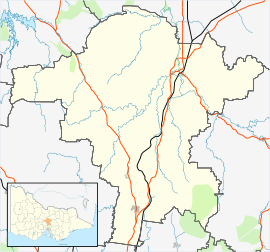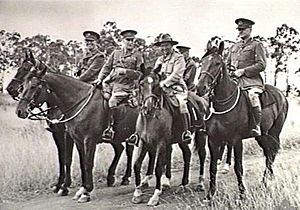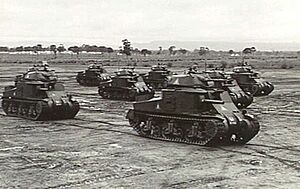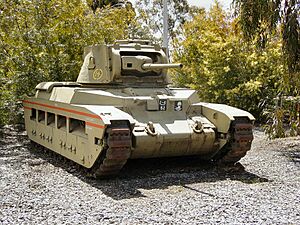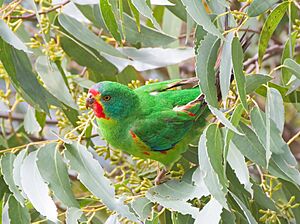Puckapunyal facts for kids
Quick facts for kids PuckapunyalVictoria |
|
|---|---|
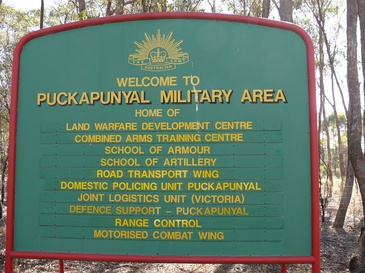
Sign at entry
|
|
| Population | 1,078 (2016 census) |
| Postcode(s) | 3662 |
| LGA(s) | Shire of Mitchell |
Puckapunyal is a special place in central Victoria. It's mostly known as an Australian Army training base. People also call it the Puckapunyal Military Area, Puckapunyal Camp, or just "Pucka."
This important base is about 10 kilometers west of Seymour. It helps train soldiers for the Australian Army.
Contents
What is Puckapunyal Like?
Puckapunyal is a small town with special access. It's home to about 280 families who are part of the Australian Defence Force. The base also has a huge area of about 400 square kilometers. This land is made up of bushland and old farms. Soldiers use it for important field training exercises.
Training and Facilities
Puckapunyal is a key place for military education. It has several important schools:
- The School of Armour, where soldiers learn about tanks.
- The School of Artillery, for learning about big guns.
- The School of Transport, which teaches how to move supplies.
It also has the Combined Arms Training Centre. This center helps different parts of the army work together. You can also find the Royal Australian Armoured Corps Memorial and Army Tank Museum here. It's a museum with many old tanks!
Life in Puckapunyal
Besides the training areas, Puckapunyal has homes for families. Most houses are single-story brick homes with backyards. The town also has a primary school, shops, and many sports facilities. There's even a theatre for entertainment.
Puckapunyal's History
Early Military Use
The Puckapunyal area was first used for military training during World War I. In the 1920s, a storage building for military supplies and a rifle range were built. In 1939, it officially became "Puckapunyal Camp." The name comes from an Aboriginal word for a large hill in the area. It has many meanings, like "death to the eagle" or "valley of the winds."
During World War II, Puckapunyal was very busy. It trained many Australian soldiers. Even American soldiers from the 41st Infantry Division trained here. The base grew much larger to fit all the training needs.
After World War II
In 1949, the 1st Armoured Regiment started at Puckapunyal. This tank regiment stayed there until 1995.
During the Vietnam War, many young men had to join the army for a short time. This was called "national service." Many of these soldiers trained at Puckapunyal. Up to 4,000 soldiers were at the base at one time.
Caring for the Land
In the 1970s, the army started a big project to fix the land at Puckapunyal. Years of heavy use had damaged the area. This project was one of the biggest land repair efforts in Australia.
The project helped fix areas that were muddy or had bad erosion. They planted new trees and plants. This made the land much healthier. It also created new homes for animals. This project showed how military training areas can also protect nature.
Puckapunyal is still used today to test armoured fighting vehicles.
Puckapunyal's Environment
The Puckapunyal Military Area has cool winters with most of its rain. Summers are dry and hot. The land has rocky hills and ridges. Mount Puckapunyal is the highest point at 413 meters. The soil is not very fertile and doesn't hold much water. All the streams on the base flow into the Goulburn River. These streams only flow during certain seasons.
Plants and Animals
Puckapunyal has a special type of forest called box-ironbark forest. This is one of the biggest parts of this forest left in Victoria. Many different plants grow here, including two types that are nationally threatened.
The area is also home to many animals. Over 44 types of mammals, 18 reptiles, 12 frogs, and 11 fish have been recorded. There are also more than 140 types of invertebrates (animals without backbones).
Important Birds
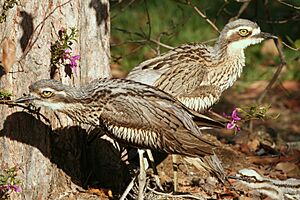
Puckapunyal is very important for birds. BirdLife International has named it an Important Bird Area (IBA). This is because it has the largest known group of bush stone-curlews in Victoria. These birds are special and need protection.
The base is also visited by endangered swift parrots. These parrots are often seen in large numbers. Other important birds found here include diamond firetails, regent and painted honeyeaters, and different types of owls and robins. In total, 207 different bird species have been seen at Puckapunyal.
Puckapunyal in Pop Culture
Puckapunyal is mentioned in a famous Australian song called "I Was Only Nineteen." This song was a number one hit for the band Redgum in 1983. It also gets a mention in episode 84 of the TV show Prisoner.


